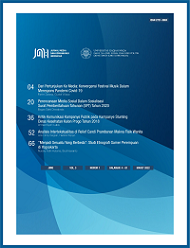Representasi Karakter Ayah Pada Film NKCTHI : Nanti Kita Cerita Tentang Hari Ini
Tigy Ambar Silvanari(1*)
(1) Pembangunan Jaya University
(*) Corresponding Author
Abstract
The background of this research is motivated by an interest in the patriarchal cultural practices that apply to Indonesian society. Where one of them is related to the dominance of men as fathers in the family sphere. A number of roles in the family are constructed in the position of the father. Film is one of the media that can portray father as the main character. The depiction of the father character in Indonesian films in the 90s has shifted from the 2000s to the present. One of the family-themed films that make the main character of the father in the current era is the NKCTHI: Nanti Kita Cerita Tanpa Hari film. This film is interesting to study, because the character of the father is shown by taking pictures from various points of view. So it would be interesting if a study was conducted on the depiction of the father's character in the NKCTHI: Nanti Kita Cerita Tentang Hari Ini film. This study uses a qualitative method with Peirce's semiotic analysis to get a picture of the representation of the father's character through the signs, objects, and interpreters in the scenes in the NKCTHI: Nanti Kita Cerita Tanpa Hari ini film. The results of this study indicate that the character of the father in this film is still represented as a dominant figure through his role as a protector so that it can be associated with the practice of patriarchal culture that is still valid in Indonesia, especially in the family sphere.
Keywords
Full Text:
PDFReferences
Abdullah, S. M. (2010). Keterlibatan Ayah dalam Pengasuhan Anak (Parental Involvement) : Sebuah Tinjauan Teoritis. Yogyakarta.
Adipoetra, F. G. (2016). Representasi Patriarki dalam Film “Batas”. 3. Surabaya
Agmassini, G. (2019,Juli 31). Pentingnya Peran Ayah pada Kepribadian Si Kecil. Retrieved from Line Today:
https://today.line.me/id/v2/article/Pentingnya+Peran+Ayah+pada+Kepribadian+Si +Kecil-kXB3L1
Andayani, B., & Koentjoro. (2012). Psikologi Keluarga: Peran Ayah Menuju Coparenting. Sidoarjo: Laros.
Arifin, Z. (2012). Penelitian Pendidikan Metode dan Paradigma Baru. Bandung: PT. Remaja Rosdakarya.
Budiman, K. (2011). Konsep Isu dan Problem Ikonisitas. Yogyakarta: Jalasutra.
Dewi, B. K. (2017, November 10). Peran Ayah dalam Tumbuh Kembang Anak 10 Nov 2017 00:00:00. Retrieved from Sahabat Keluarga, Kementrian Pendidikan dan Kebudayaan: https://sahabatkeluarga.kemdikbud.go.id/laman/index.php?r=tpost/xview&id=4457
Diananto, W. (2020, Januari 22). Film NKCTHI Akhirnya Tembus 2 Juta Penonton. Retrieved from Liputan 6: https://www.liputan6.com/showbiz/read/4161229/film-nkcthi-akhirnya-tembus-2-juta-penonton
Djoharwinarlien, S. (2012). Dilema Kesetaraan Gender. Yogyakarta: Research Center for Politics and Government (PolGov).
Eliyanah, E. (2018). Dari Rangga ke Khudori, ‘laki-laki baru’ di film Indonesia. Retrieved from The Conversation: https://theconversation.com/dari-rangga-ke-khudori-laki-laki-baru-di-film-indonesia-82759
Fiske, J. (2012). Pengantar Ilmu Komunikasi. Jakarta: PT. Rajagrafindo Persada.
Forno, D. M. (2015). Penggambaran Karakter pada Tokoh Utama dalam Film Maleficent. Surabaya.
Hidayat, L. (2019, Ferbruary 24). Sederhana Tapi Penting, Inilah Manfaat Menonton Film Keluarga. Retrieved from Futuready: https://www.futuready.com/artikel/family/sederhana-tapi-penting-inilah-manfaat-menonton-film-keluarga/
Ibrahim, I. S. (2011). Budaya Populer Sebagai Komunikasi, Dinamika Popscape dan Mediascape di Indonesia Kontemporer. Yogyakarta: Jalasutra.
Jannidis, F. (2013). The Living Handbook of Narratology. Hamburg: Hamburg University Press.
Javandalasta. (2011). 5 Hari Mahir Membuat Film. Jakarta: Gramedia.
Lestari, S. (2012). Psikologi Keluarga Penanaman Nilai dan Penanganan Konflik dalam Keluarga. Jakarta: Kencana Prenada Media Group.
Luviana. (2020, Januari 20). Film NKCTHI: Ini Cerita tentang Keluarga yang Normatif dan Patriarki. Retrieved from Konde.co: https://www.konde.co/2020/01/film-nkcthi-ini-cerita-tentang-keluarga.html
Noor, D. A. (2020, Juli 24). Bangga, Film NKCTHI Akan Tayang 2 Kali di Shanghai International Film Festival. Retrieved from Askara.co: https://www.askara.co/read/2020/07/24/7003/bangga-film-nkcthi-akan-tayang-2-kali-di-shanghai-international-film-festival-
Parmati, & Punamasari, S. (2015). Peran Ayah Dalam Pengasuhan Anak. Yogyakarta.
Widiyasa, P. P. (2017). Representasi Maskulinitas pada Sosok Ayah di Majalah Keluarga Ayahbunda.
Rahman, I. M. (2020, Juli 15). Wow! Inilah 5 Fakta Mencengangkan Budaya Patriarki di Indonesia! Retrieved from HerStory: https://herstory.co.id/read5039/wow-inilah-5-fakta-mencengangkan-budaya-patriarki-di-indonesia
Ratna, N. K. (2012). Penelitian Sastra: Teori, Metode dan Teknik. Yogyakarta: Pustaka Pelajar.
Revitasari, F. (2019, April 29). 5 Alasan Kenapa Budaya Patriarki Masih Ada di Indonesia. Retrieved from IDN Times: https://www.idntimes.com/life/women/vita/alasan-budaya-patriarki-masih-ada-di-indonesia/5
Rizqullah, R. '. (2019, Maret 02). Perempuan dalam Dominasi Patriark. Retrieved from Medium.com: https://medium.com/lingkaran-solidaritas/perempuan-dalam-dominasi-patriarki-b7659347e9d7
Rokhmansyah, A. (2013). Pengantar Gender dan Feminisme. Yogyakarta : Garudhawaca.
Romli, K. (2016). Komunikasi Massa. Jakarta: PT. Grasindo.
Sakina, A., & Siti, D. H. (2017) Menyoroti Budaya Patriarki di Indonesia. 72. Bandung.
Skata. (2020, Januari 6). Ayah, Biarkan Anakmu Merasakan Gagal dan Kecewa (Review Film NKCTHI). Retrieved from Kumparan: https://kumparan.com/skata/ayah-biarkan-anakmu-merasakan-gagal-dankecewa-review-film-nkcthi-1saaIqDVy3S/full
Sobur, A. (2014). Semiotika Komunikasi. Bandung: PT. Remaja Rosdakarya.
Soedjono, & Abdurrahman. (2005). Metode Penelitian Suatu Pemikiran dan Penerapan. Jakarta: Rineka Cipta.
Sukarno, E. (2019, Oktober 9). Perempuan dalam Cengkraman Budaya Patriarki. Retrieved from Radarjogja: https://radarjogja.jawapos.com/2019/10/09/perempuan-dalam-cengkraman-budaya-patriarki/
Suyanto, B. (2020, Februari 29). Bias Patriarki dalam RUU Ketahanan Keluarga. Retrieved from Media Indonesia: https://mediaindonesia.com/read/detail/293282-bias-patriarki-dalam-ruu-ketahanan-keluarga
Tan, P. (2014, Januari 10). Mendobrak Patriarki dalam Rumah Tangga. Retrieved from Kompasiana: https://www.kompasiana.com/poedjiatitan/5528ba30f17e610a7c8b4694/mendobrak-patriarki-dalam-rumah-tangga
Tinarbuko, S. (2008). Semiotika Komunikasi Visual
West, R., & Turner, L. H. (2012). Pengantar Teori Komunikasi Analisis dan Aplikasi. Jakarta: Salemba Humanika.
Wibowo, I. S. (2013). Semiotika Komunikasi. Aplikasi Praktis Bagi Penelitia dan Skripsi Komunikasi. Jakarta: Mitra Wacana Media.
Wright, M. O., Masten, A. S., & Narayan, A. J. (2013). Resilience Processes in Development: Four Waves of Research on Positive Adaptation in the Context of Adversit. 15-37. New York : Springers US.
Article Metrics
Refbacks
- There are currently no refbacks.
Copyright (c) 2021 Jurnal Media dan Komunikasi Indonesia
| Jurnal Media dan Komunikasi Indonesia (Online ISSN 2721-396X) is published by the Department of Communication Science (DIKOM), Faculty of Social Science and Political Science (FISIPOL), Gadjah Mada University |












